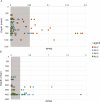High abundance of hydrocarbon-degrading Alcanivorax in plumes of hydrothermally active volcanoes in the South Pacific Ocean
- PMID: 36721059
- PMCID: PMC10030979
- DOI: 10.1038/s41396-023-01366-4
High abundance of hydrocarbon-degrading Alcanivorax in plumes of hydrothermally active volcanoes in the South Pacific Ocean
Abstract
Species within the genus Alcanivorax are well known hydrocarbon-degraders that propagate quickly in oil spills and natural oil seepage. They are also inhabitants of the deep-sea and have been found in several hydrothermal plumes. However, an in-depth analysis of deep-sea Alcanivorax is currently lacking. In this study, we used multiple culture-independent techniques to analyze the microbial community composition of hydrothermal plumes in the Northern Tonga arc and Northeastern Lau Basin focusing on the autecology of Alcanivorax. The hydrothermal vents feeding the plumes are hosted in an arc volcano (Niua), a rear-arc caldera (Niuatahi) and the Northeast Lau Spreading Centre (Maka). Fluorescence in situ hybridization revealed that Alcanivorax dominated the community at two sites (1210-1565 mbsl), reaching up to 48% relative abundance (3.5 × 104 cells/ml). Through 16S rRNA gene and metagenome analyses, we identified that this pattern was driven by two Alcanivorax species in the plumes of Niuatahi and Maka. Despite no indication for hydrocarbon presence in the plumes of these areas, a high expression of genes involved in hydrocarbon-degradation was observed. We hypothesize that the high abundance and gene expression of Alcanivorax is likely due to yet undiscovered hydrocarbon seepage from the seafloor, potentially resulting from recent volcanic activity in the area. Chain-length and complexity of hydrocarbons, and water depth could be driving niche partitioning in Alcanivorax.
© 2023. The Author(s).
Conflict of interest statement
The authors declare no competing interests.
Figures





References
-
- German CR, Von Damm KL. Hydrothermal processes. In: Holland HD, Turekian KK and Elderfield H, editors. Treatise geochem, Vol. 6. The oceans and marine geochemistry. Oxford, UK:Elsevier-Pergamon, 2004;181–222.
-
- McCollom TM. Geochemical constraints on primary productivity in submarine hydrothermal vent plumes. Deep Res Part I Oceanogr Res Pap. 2000;47:85–101. doi: 10.1016/S0967-0637(99)00048-5. - DOI
-
- Tunnicliffe V, Baross JA, Gebruk AV, Giere O, Holland ME, Koschinsky A, et al. Group report: what are the interactions between biotic processes at vents and physical, chemical, and geological conditions. In: Halbach PE, Tunnicliffe V, and Hein JR, editors. Energy and Mass Transfer in Marine Hydrothermal Systems. Berlin-Dahlem:University Press; 2003;251–70.
-
- Nakamura K, Takai K. Theoretical constraints of physical and chemical properties of hydrothermal fluids on variations in chemolithotrophic microbial communities in seafloor hydrothermal systems. Prog Earth Planet Sci. 2014;1:1–24. doi: 10.1186/2197-4284-1-5. - DOI

